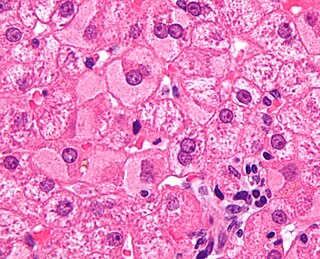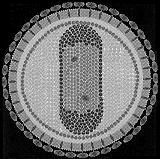Related Research Articles

Cervicitis is inflammation of the uterine cervix. Cervicitis in women has many features in common with urethritis in men and many cases are caused by sexually transmitted infections. Non-infectious causes of cervicitis can include intrauterine devices, contraceptive diaphragms, and allergic reactions to spermicides or latex condoms. Cervicitis affects over half of all women during their adult life.

Viral hepatitis is liver inflammation due to a viral infection. It may present in acute form as a recent infection with relatively rapid onset, or in chronic form.

Equine infectious anemia or equine infectious anaemia (EIA), also known by horsemen as swamp fever, is a horse disease caused by a retrovirus and transmitted by bloodsucking insects. The virus (EIAV) is endemic in the Americas, parts of Europe, the Middle and Far East, Russia, and South Africa. The virus is a lentivirus, like human immunodeficiency virus (HIV). Like HIV, EIA can be transmitted through blood, milk, and body secretions. Transmission is primarily through biting flies, such as the horse-fly and deer-fly. The virus survives up to 4 hours in the vector. Contaminated surgical equipment and recycled needles and syringes, and bits can transmit the disease. Mares can transmit the disease to their foals via the placenta. The risk of transmitting the disease is greatest when an infected horse is ill, as the blood levels of the virus are then highest.
Vulvitis is inflammation of the vulva, the external female mammalian genitalia that include the labia majora, labia minora, clitoris, and introitus. It may co-occur as vulvovaginitis with vaginitis, inflammation of the vagina, and may have infectious or non-infectious causes. The warm and moist conditions of the vulva make it easily affected. Vulvitis is prone to occur in any female especially those who have certain sensitivities, infections, allergies, or diseases that make them likely to have vulvitis. Postmenopausal women and prepubescent girls are more prone to be affected by it, as compared to women in their menstruation period. It is so because they have low estrogen levels which makes their vulvar tissue thin and dry. Women having diabetes are also prone to be affected by vulvitis due to the high sugar content in their cells, increasing their vulnerability. Vulvitis is not a disease, it is just an inflammation caused by an infection, allergy or injury. Vulvitis may also be symptom of any sexually transmitted disease or a fungal infection.
California encephalitis orthobunyavirus type strain California encephalitis virus was discovered in Kern County, California, and causes encephalitis in humans. Encephalitis is an acute inflammation of the brain that can cause minor symptoms, such as headaches, to more severe symptoms such as seizures. Mosquitoes serve as its carrier and for this reason this virus is known as an arbovirus.

Canine influenza is influenza occurring in canine animals. Canine influenza is caused by varieties of influenzavirus A, such as equine influenza virus H3N8, which was discovered to cause disease in canines in 2004. Because of the lack of previous exposure to this virus, dogs have no natural immunity to it. Therefore, the disease is rapidly transmitted between individual dogs. Canine influenza may be endemic in some regional dog populations of the United States. It is a disease with a high morbidity but a low incidence of death.
Viral encephalitis is inflammation of the brain parenchyma, called encephalitis, by a virus. The different forms of viral encephalitis are called viral encephalitides. It is the most common type of encephalitis and often occurs with viral meningitis. Encephalitic viruses first cause infection and replicate outside of the central nervous system (CNS), most reaching the CNS through the circulatory system and a minority from nerve endings toward the CNS. Once in the brain, the virus and the host's inflammatory response disrupt neural function, leading to illness and complications, many of which frequently are neurological in nature, such as impaired motor skills and altered behavior.
H3N8 is a subtype of the species Influenza A virus that is endemic in birds, horses and dogs. It is the main cause of equine influenza and is also known as equine influenza virus. In 2011, it was reported to have been found in seals. Cats have been experimentally infected with the virus, leading to clinical signs, shedding of the virus and infection of other cats.
Aujeszky's disease, usually called pseudorabies in the United States, is a viral disease in swine that has been endemic in most parts of the world. It is caused by Suid herpesvirus 1 (SuHV-1). Aujeszky's disease is considered to be the most economically important viral disease of swine in areas where classical swine fever has been eradicated. Other mammals, such as cattle, sheep, goats, cats, dogs, and raccoons, are also susceptible. The disease is usually fatal in these animal species.
Equid alphaherpesvirus 3, formerly Equine herpesvirus 3 (EHV-3), is a virus of the family Herpesviridae that affects horses.
Equid alphaherpesvirus 4, formerly Equine herpesvirus 4 (EHV-4) is a virus of the family Herpesviridae that cause rhinopneumonitis in horses. It is the most important viral cause of respiratory infection in foals. Like other herpes viruses, EHV-4 causes a lifelong latent infection in affected animals. These horses are usually the source for new infection for foals over two months old, weanlings, and yearlings. Symptoms include fever, loss of appetite, and discharge from the nose. Most infected animals recover in one to three weeks, but death can occur in environments with overcrowding and other stress factors. There are several vaccines available.
Equid alphaherpesvirus 1, formerly Equine herpesvirus 1 (EHV-1), is a virus of the family Herpesviridae that causes abortion, respiratory disease and occasionally neonatal mortality in horses. Initial spread of EHV-1 by a newly introduced horse through direct and indirect contact can lead to abortion and perinatal infection in up to 70 percent of a previously unexposed herd. Abortion usually occurs in the last four months of gestation, two to four weeks after infection of the mare. Perinatal infection can lead to pneumonia and death. Encephalitis can occur in affected animals, leading to ataxia, paralysis, and death. There is a vaccine available, however its efficacy is questionable. The virus varies in severity from sub-clinical to very severe. Most horses have been infected with EHV-1, but the virus can become latent and persist without ever causing signs of infection. In 2006, an outbreak of EHV-1 among stables in Florida resulted in the institution of quarantine measures. The outbreak was determined to have originated in horses imported from Europe via New York, before being shipped to Florida.
Equine viral arteritis (EVA) is a disease of horses caused by a virus of the species Alphaarterivirus equid, an RNA virus. It is the only species in the genus Alphaarterivirus, and that is the only genus in the Equarterivirinae subfamily. The virus which causes EVA was first isolated in 1953, but the disease has afflicted equine animals worldwide for centuries. It has been more common in some breeds of horses in the United States, but there is no breed "immunity". In the UK, it is a notifiable disease. There is no known human hazard.
Taylorella is a genus comprising Gram-negative, short rod-shaped, chemoorganotrophic bacteria that include species that are the causative agents of contagious equine metritis. The name Taylorella serves as a dedication to C.E.D. Taylor, the scientist who identified the only species originally included in this genus. They are non-motile microaerophiles that are able to be isolated in pure culture on chocolate agar..
Contagious equine metritis (CEM) is a type of metritis in horses that is caused by a sexually transmitted infection. It is thus an equine venereal disease of the genital tract of horses, brought on by the Taylorella equigenitalis bacteria and spread through sexual contact. The disease was first reported in 1977, and has since been reported worldwide.
The Iowa Animal Industry Bureau is the governmental agency in the state of Iowa, United States, that regulates livestock health and livestock identification. Administratively it is under the Iowa Department of Agriculture and Land Stewardship and its director is the State Veterinarian. The bureau also administratively supports the Iowa Board of Veterinary Medicine.

Metritis is inflammation of the wall of the uterus, whereas endometritis is inflammation of the functional lining of the uterus, called the endometrium. The term pelvic inflammatory disease (PID) is often used for metritis.
Theiler's disease is a viral hepatitis that affects horses. It is one of the most common cause of acute hepatitis and liver failure in the horse.
A Foreign animal disease (FAD) is an animal disease or pest, whether terrestrial or aquatic, not known to exist in the United States or its territories. When these diseases can significantly affect human health or animal production and when there is significant economic cost for disease control and eradication efforts, they are considered a threat to the United States. Another term gaining preference to be used is Transboundary Animal Disease (TAD), which is defined as those epidemic diseases which are highly contagious or transmissible and have the potential for very rapid spread, irrespective of national borders, causing serious socio-economic and possibly public health consequences. An Emerging Animal Disease "may be defined as any terrestrial animal, aquatic animal, or zoonotic disease not yet known or characterized, or any known or characterized terrestrial animal or aquatic animal disease in the United States or its territories that changes or mutates in pathogenicity, communicability, or zoonotic potential to become a threat to terrestrial animals, aquatic animals, or humans."
References
- ↑ Michael Ball, D. (1997, September 1). Equine Herpes Virus. Retrieved December 2, 2009, from The Horse: http://www.thehorse.com/Print.aspx?ID=668
- ↑ Zoologix. (n.d.). Equine herpesvisur type III (EHV-3). Retrieved December 10, 2009, from Zoologix: http://www.zoologix.com/horse/Datasheets/EquineHerpesvirusTypeIII.htm
- 1 2 Animal and Plant Health Inspection Service. (2005, June). Contagious Equine Metritis. Retrieved from United States Department of Agriculture Animal and Plant Health Inspection Service: http://www.aphis.usda.gov/publications/animal_health/content/printable_version/fs_ahcem.pdf Archived 2010-01-09 at the Wayback Machine